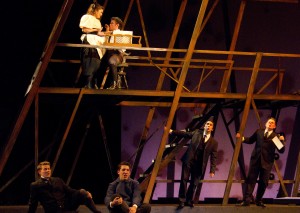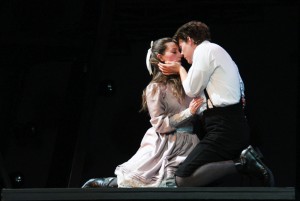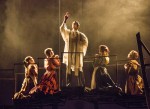With nudity and themes of sexuality and suicide, UCLA’s production of the 2006 Broadway hit “Spring Awakening” comes full force in telling a coming-of-age story.
Tonight at the Freud Playhouse, the UCLA School of Theater, Film and Television presents the Tony Award-winning rock musical “Spring Awakening,” which focuses on prevalent themes including sexual identity, gender roles and abuse. This production incorporates different elements in the popular musical with its double casting and use of a larger-scale set.
Based on Frank Wedekind’s German play “Spring Awakening,” this musical follows the tumultuous journey of rural adolescents during late 19th-century Germany: Wendla is a young innocent girl whose life takes a sharp turn when she becomes unexpectedly pregnant by the rebellious Melchior. Confused and lost, Melchior’s best friend Moritz also finds himself contemplating suicide.
 [media-credit id=4160 align=”alignright” width=”300″]
[media-credit id=4160 align=”alignright” width=”300″]
“It’s like a time machine: The scenes and costumes are very formal, yet it’s the (rock) music that makes the show very contemporary,” said musical theater professor and director Nicholas Gunn. “There’s a constant going back and forth from the two.”
Gunn said because the actors are constantly going back and forth from the 1890s to the contemporary, the production also has been a very slow, laborious and complicated process.
With auditions beginning before spring break to an eight-week rehearsal project immediately following that, about 40 members of both crew and all undergraduate cast have been able to cater to details both large and small.
 [media-credit id=4160 align=”alignright” width=”300″]
[media-credit id=4160 align=”alignright” width=”300″]
“We have a student who designed this large-scale set and another who is the sound designer,” Gunn said. “Each light also has to get assigned a cue. In one scene alone, there’s 26 lighting cues.”
The four main leads were also double cast in efforts to allow more opportunities for these actors, Gunn said. While all other cast members will perform every night, these specific eight actors will alternate between the 10 performances.
Through the show’s lengthy process, the four double cast leads were essentially able to explore their artistic choices. Third-year theater student Mike Starr, who plays the protagonist Melchior, said they were not limited in their acting decisions.
“The great thing about this process is that we really had time to sit with the material and molded it to what each cast felt was right,” he said. “Through different timing and movement, two different shows are essentially made.”
However, there are still a few things that both casts have in common, like fostering a mature work ethic both on and off the stage.
“We do have nudity in this play, but because we’ve got such a professional and mature cast, it has been really easy for me as a director to create a safe environment for everyone all throughout production,” Gunn said. “It’s really been nothing but a pleasure to work with them all.”
Both casts also include the employment of the classic American dialect, which is neutral of time and place, but is characterized by a rather strict and formal tone, said third-year theater student Kim Moore, who plays Wendla.
“This dialect ultimately makes the show’s content more universal as opposed to affecting the German accent usually associated with this play,” she said.
Nonetheless, superseding many of the technical aspects, Gunn said it is the aspect of universality that plays an important role in the show’s production.
“Characters are just words on a page,” Moore said. “It’s up to the actor to communicate to the audience in a way that really affects them and resonates with them, and that’s what we’ve striven to do with this production.”
